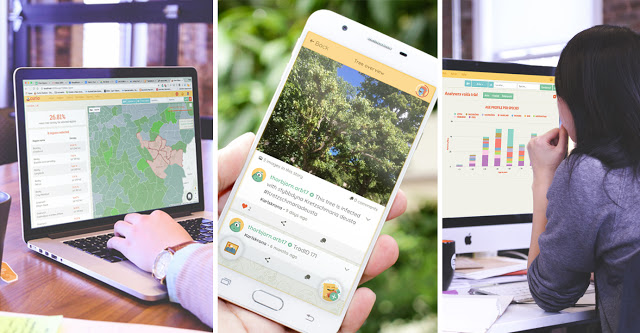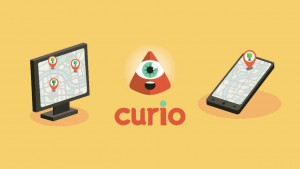Part One of Curio Series: Protect Urban Forests With Curio
Posted on Categories Discover Magazine

This post is part one of a three-part series about how Curio can help citizens recognize, appreciate, and care for the highly beneficial green spaces around them.
The word “forest” can conjure an image of distant, thickly wooded area, straight from a Brothers Grimm fairy tale. Curio, an app and website, brings trees a little closer to home. This is a platform for people worldwide to tell their own tree stories, discovering and mapping “urban forests” right outside their doors. Curio is easy to use: once you download the app or go to the website, you can take a picture of a tree, write a story about what the tree means to you, or perhaps ask an expert a question about that particular tree. You can also use Curio’s map to find other interesting trees around you. Through providing this platform and making the data collected publicly available for analysis, Curio aims to educate users about trees, promote tree-based research, and inspire appreciation for all green spaces, both rural and urban.
The Importance of Green Spaces
Why are green spaces so important?
In a city, these spaces can help improve air quality and regulate temperature. Having plenty of green spaces and trees can also help to protect local water quality — the roots in the ground act as natural water filters. In addition, trees can reduce soil erosion, with roots holding soil in place.
A green environment is also important for our brains. Studies have shown that spending time outdoors can help improve moods, overall mental health, and even enhance productivity at work and home.
Green spaces and urban environments can initially appear to be mutually exclusive. That’s where Curio comes in. By creating a map of trees, Curio allows you to appreciate and understand the green spaces that exist where you live.
What Is Curio?
Trees are living history. Their rings show us everything, from what the climate was like in a given year to when there were natural disasters that the tree survived. If a tree falls, though, that history could be lost. If it’s story hasn’t been documented, will that tree make a sound?
Curio uses geolocation and citizen science to map trees in your area. Once you’ve identified your tree — either by yourself or by using the collective knowledge of the Curio community — your post will be linked to a great cache of resources and information about the tree, its habitat, and the ecosystem that it lives in and supports.
Conor Nugent created Curio with Paul Hickey. “Our goal is to help connect people both with their local environment and the people who care for it,” said Nugent. “Trees and plants do so much to help make cities livable places. By helping people learn more about trees and all the things they do for us, we hope to enrich people’s view of the world around them and help them better understand climate change and the broader environment. There are lots great projects in this space, and one of our big goals in creating Curio was to help support, connect, and showcase environmental projects and groups through the platform and tools we have developed.”
This app is available on both Apple and Android devices and is good for anyone who is interested in trees, from a hobbyist to a professional arborist. The app allows you to understand your local habitat and keep track of the things that affect it.
Benefits of Citizen Science
What does this kind of citizen science do for environmental science overall?
We often look at trees, but how often do we really see them? Curio works by making us see the trees and by increasing public awareness of the trees that we have. “Our users’ contributions make so much possible. Every tree, photo, story, or observation collected adds to a global database that can be used for a range of scientific, planning, operational, and educational purposes,” said Nugent.
With this project, we begin to see trees as an important part of our cities and gain a better understanding of our environment. Citizen science can be a tool for cities — and citizens — to protect their local environment. “For instance,” Nugent noted, “in the case of a threat like Emerald Ash Borer (EAB), which is sadly sweeping across the USA, Curio can be used to map ash trees, educate the public about the issue, identify infections, plan inspections, and track the spread of EAB.”
In other instances, Curio citizen scientists are encouraging others to learn more about their local trees and the environment they live in. “At Hivilan Utbildning College in Sweden, (they) have used Curio to map their campus trees and turn them into an educational resource for their students and the public.”
There’s so much that your community can discover with Curio. What’s in your front yard?
Want more citizen science? Check out SciStarter’s Project Finder! With 1100+ citizen science projects spanning every field of research, task and age group, there’s something for everyone!
Megan Ray Nichols
Megan Ray Nichols is a freelance science writer and the editor of Schooled By Science. She regularly writes for The Naked Scientists, Astronomy Magazine, and IoT Evolution. When she isn’t writing, Megan enjoys exploring new hiking trails, finding a new book to read or catching up on episodes of Dr. Who. Keep in touch with Megan by following her on Twitter and subscribing to her blog.

